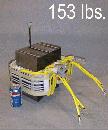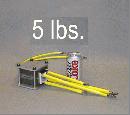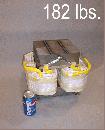 |
| |||||||||||
APPLETON, Wis., April 8, 2003 –As part of its effort to design smaller, lighter and more powerful-per-pound welding power sources, Miller Electric Mfg. Co. has introduced Fast Switch inverter technology. Products based on Fast Switch technology will operate at a frequency of 100,000 Hz (100 kHz). This is two to five times faster than current inverter or chopper technology and more than 1,000 times faster than conventional welding technology.
A basic premise of welding power source design states that a faster operating frequency enables the power source to use fewer copper windings and a smaller core in its transformer and inductor (the heaviest components of a welder–Fig. 1 thru 4). Miller plans to introduce its first Fast Switch products in mid-2003. These products will weigh less than 13 lbs. and have an output of 150 amps at 30 percent duty cycle.
"Reducing the size and weight of a welding power source increases its portability and convenience," says Mike Sammons, business unit manager, Miller Electric. "Given that labor accounts for 85 percent of a finished weld's cost, portable Fast Switch inverters make good business sense. The operator can quickly bring the welder to the work site to complete jobs faster."
Industries benefiting from portability include mechanical contracting, food/beverage, aerospace, shipbuilding, petrochemical, dairy, maintenance/repair and construction. Some Miller Fast Switch products will be priced to add appeal to non-industrial welders involved with farm/ranch, sport aviation and motorsports applications.
Low Stress Leads to Long Life
Miller anticipates that products based on Fast Switch technology will exceed the reliability rating of existing inverters, and inverters such as Miller's Maxstar® TIG/Stick products already set the industry standard for reliability in their category. Fast Switch technology increases reliability because it reduces the stress on the power switching semiconductor, called an IGBT.
With semiconductors, the secret to a long life is to reduce their operating temperature. There is an equation which basically states that every 10 C temperature increase cuts an IGBT's life in half.
"Engineers at Miller developed new circuits, cooling mechanisms and other techniques so that the IGBTs are living in luxury compared to competitive designs," says Sammons. "That's why Miller inverters lead long, stress-free lives. Also remember that Miller develops its duty cycle rating at an ambient temperature of 40 C to ensure continued performance in hot weather conditions."
The inverter (IGBT) portion of an inverter-based welding power source creates high operating frequencies by switching primary electrical power on and off very rapidly. But as fast as IGBTs switch, they do not switch in zero time. If voltage and current is flowing through the IGBT when it turns on or shuts off, its temperature increases. Previously, IGBT switching speed was limited because attempting to switch at higher frequencies generated too much heat. While increasing the size of the IGBTs and/or heat sinks would dissipate more heat, this defeats the goal of reducing size.
Fast Switch technology minimizes heat generation by ramping the total power to zero before switching. This lowers the IGBT's operating temperature and enables Miller to increase switching frequency by 40,000 Hz over its existing design. As a result of operating at 100,000 Hz, the transformer and inductor in the first Fast Switch product will weigh about 1.5 lbs. each and be about the size of a golf ball (Fig. 5). Heat sinks are also smaller because of their efficient design.
Inverter Advantages
Compared to conventional power sources, inverter-based welding power sources offer the following advantages:
- Lightweight and portable
- Able to obtain superior Stick welding performance with all electrode types
- Multi-process welding output without sacrificing arc performance in any mode
- Quick response to changing arc conditions (e.g., maintains a steady weld output even if the operator's hand shakes)
- Superior control over pulsed welding processes
- Line voltage independent–uses single- or three-phase input power and multiple input voltages without any manual relinking mechanism
- Better power factor (more efficient use of power from the utility)
- Less susceptibility to primary voltage fluctuations (e.g., "dirty power")
For more information on Miller inverters, visit Miller's Web site at www.MillerWelds.com.




